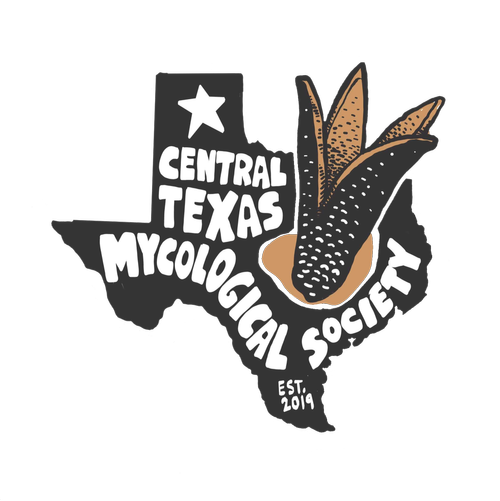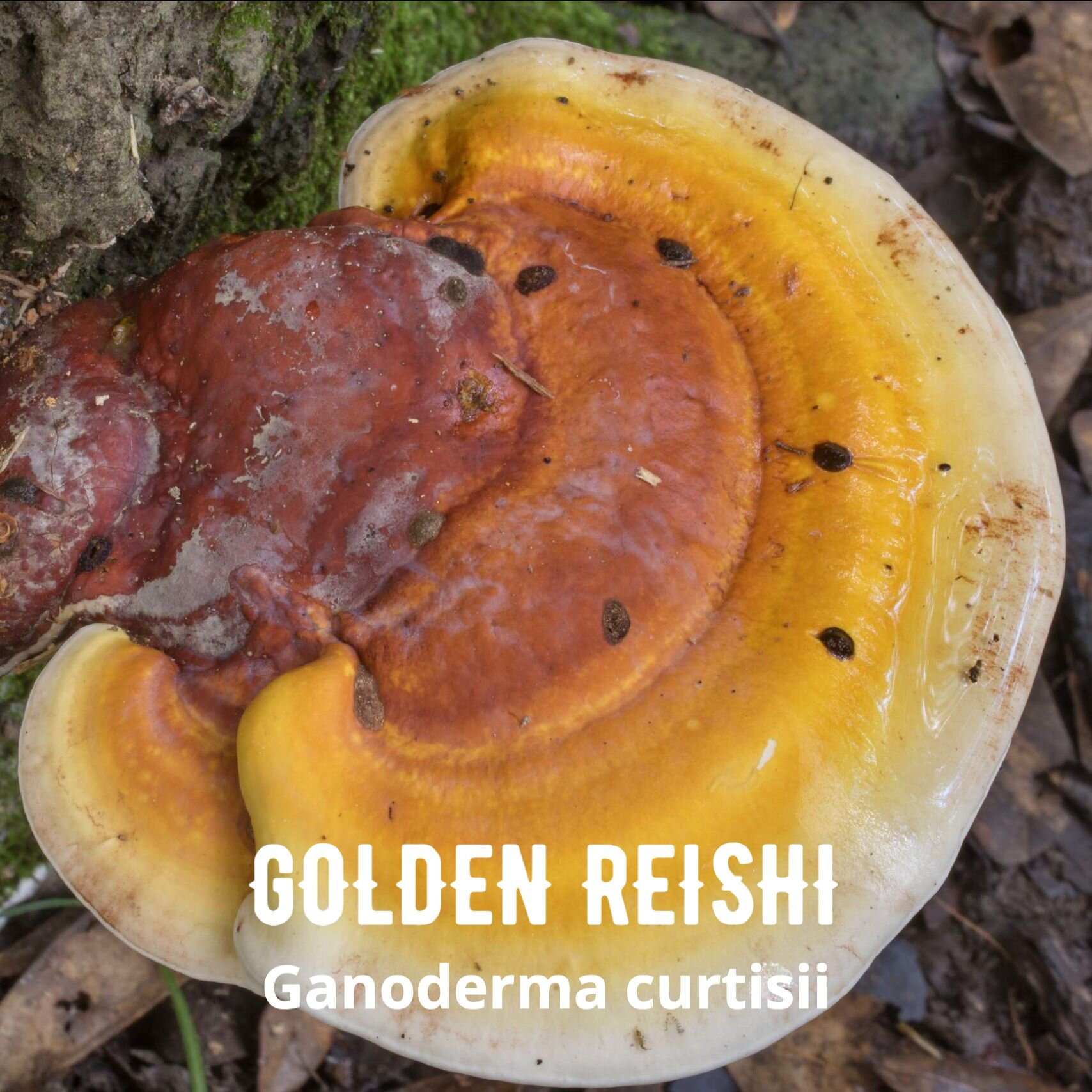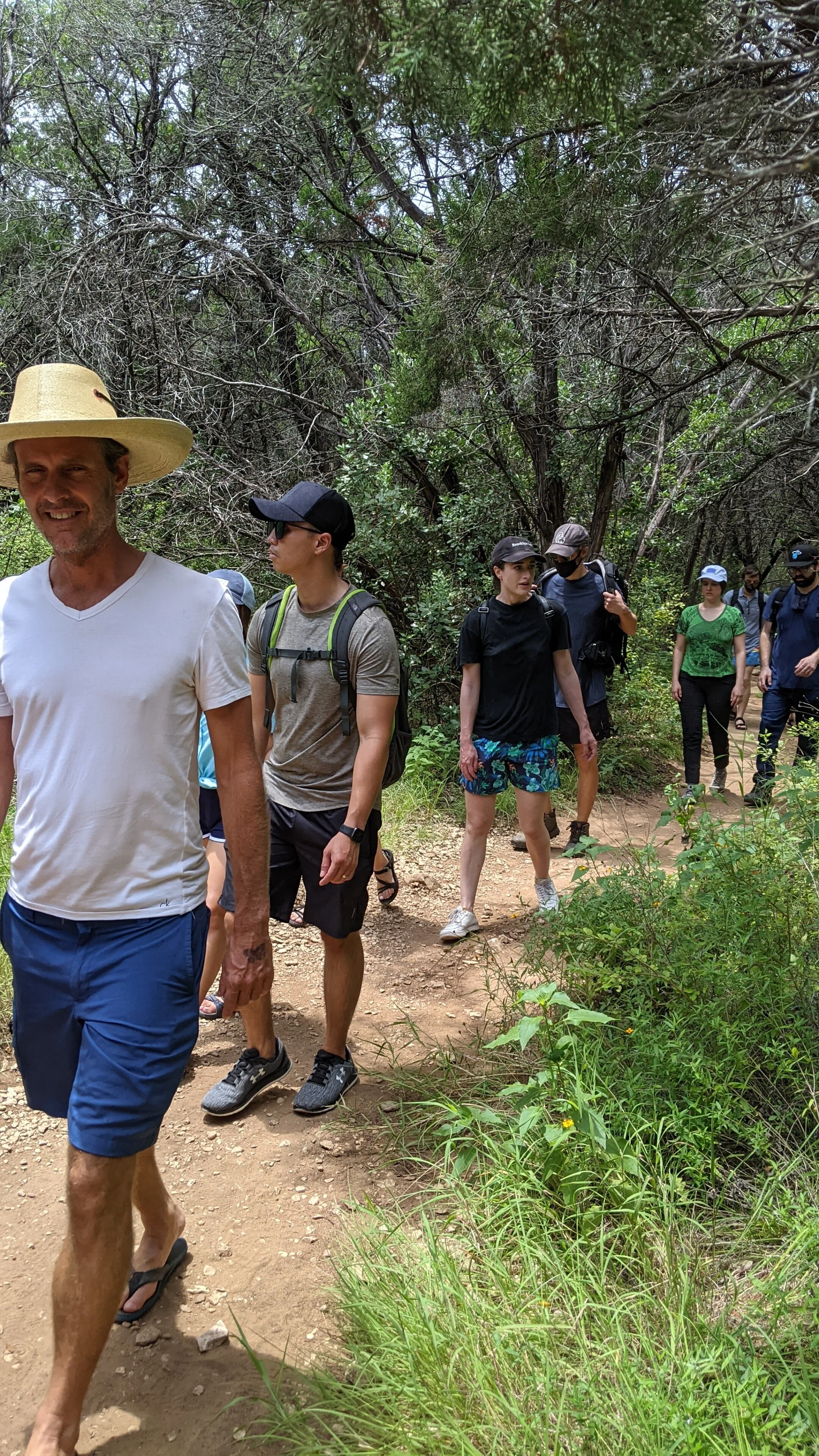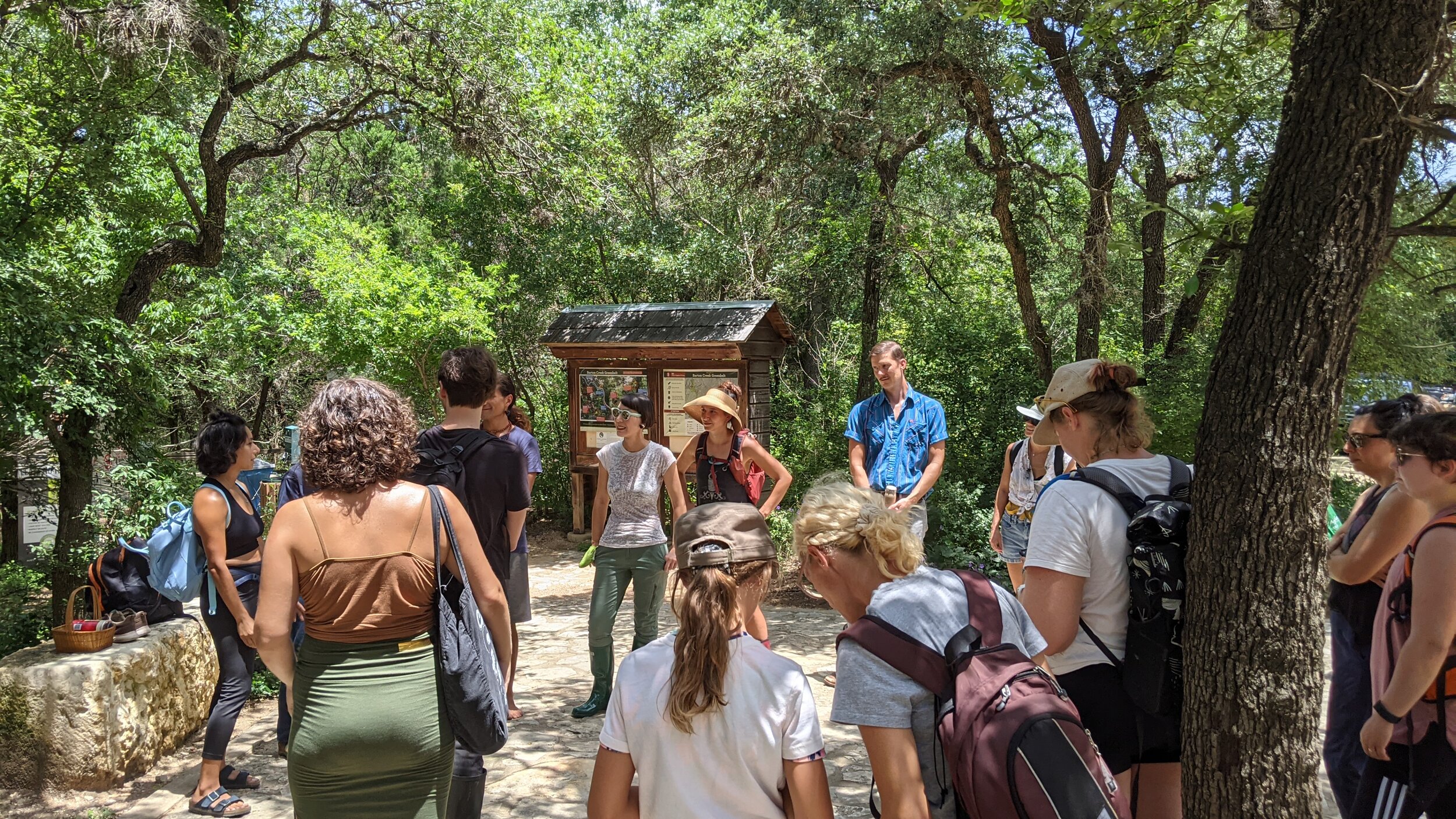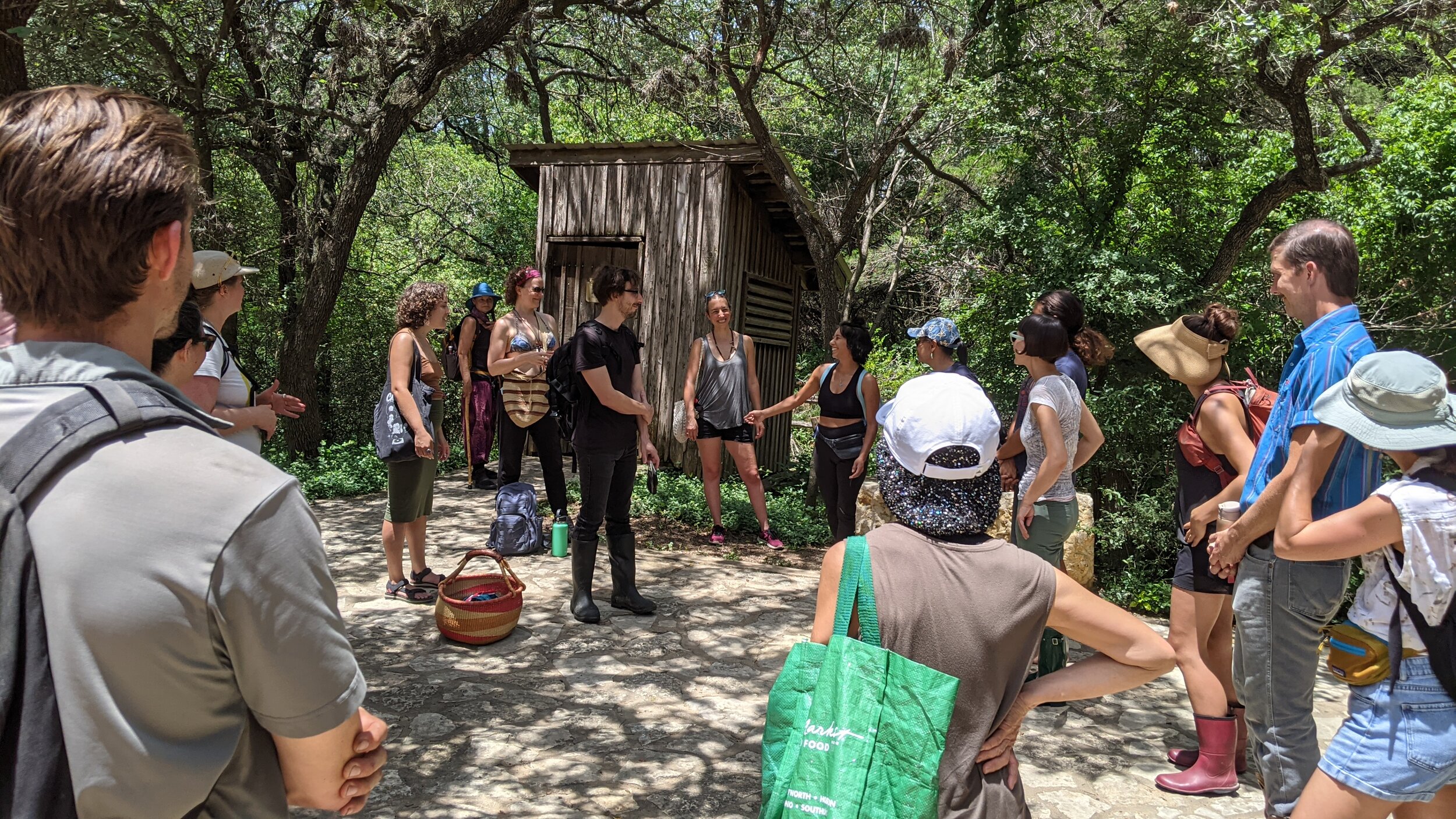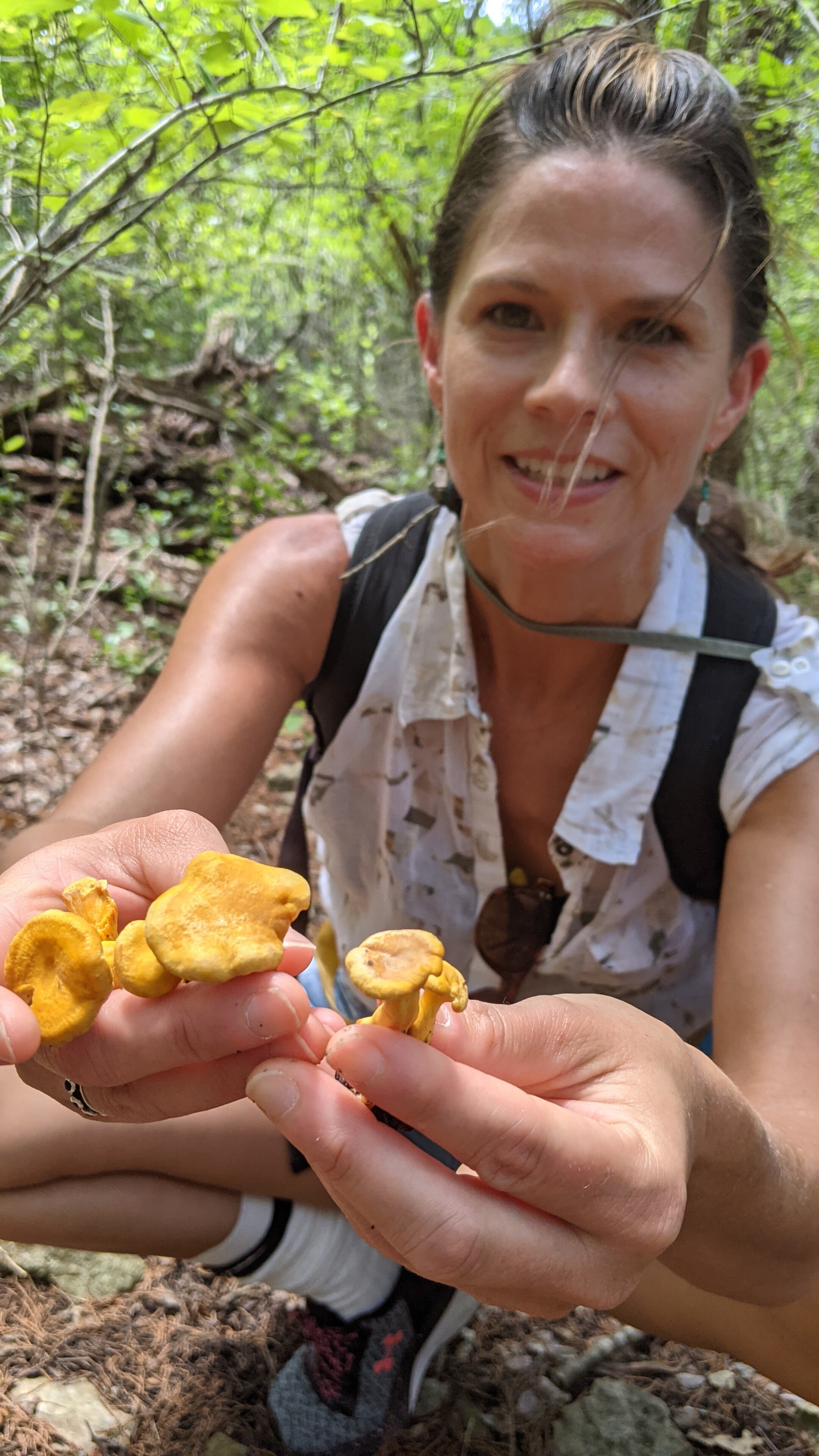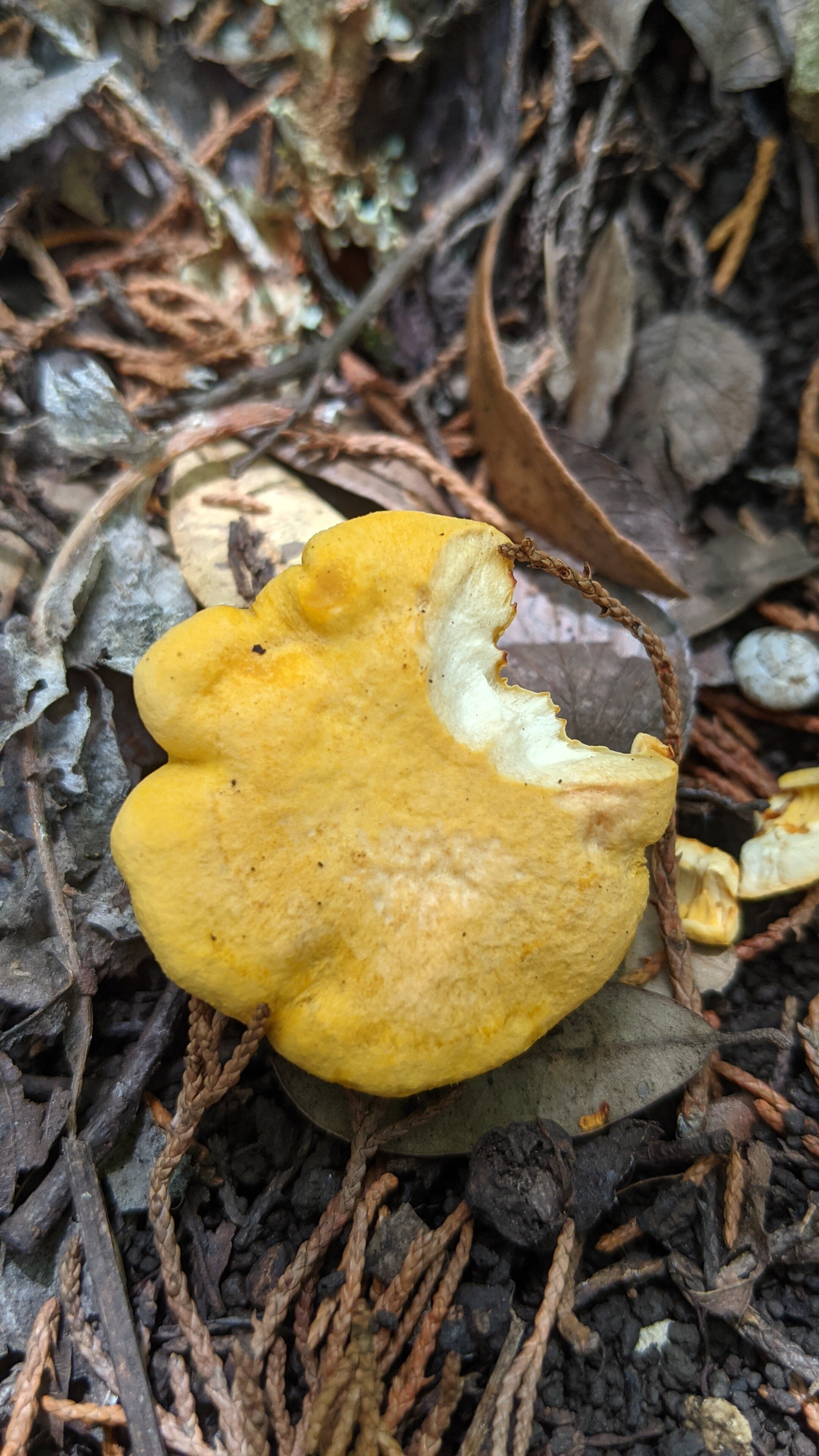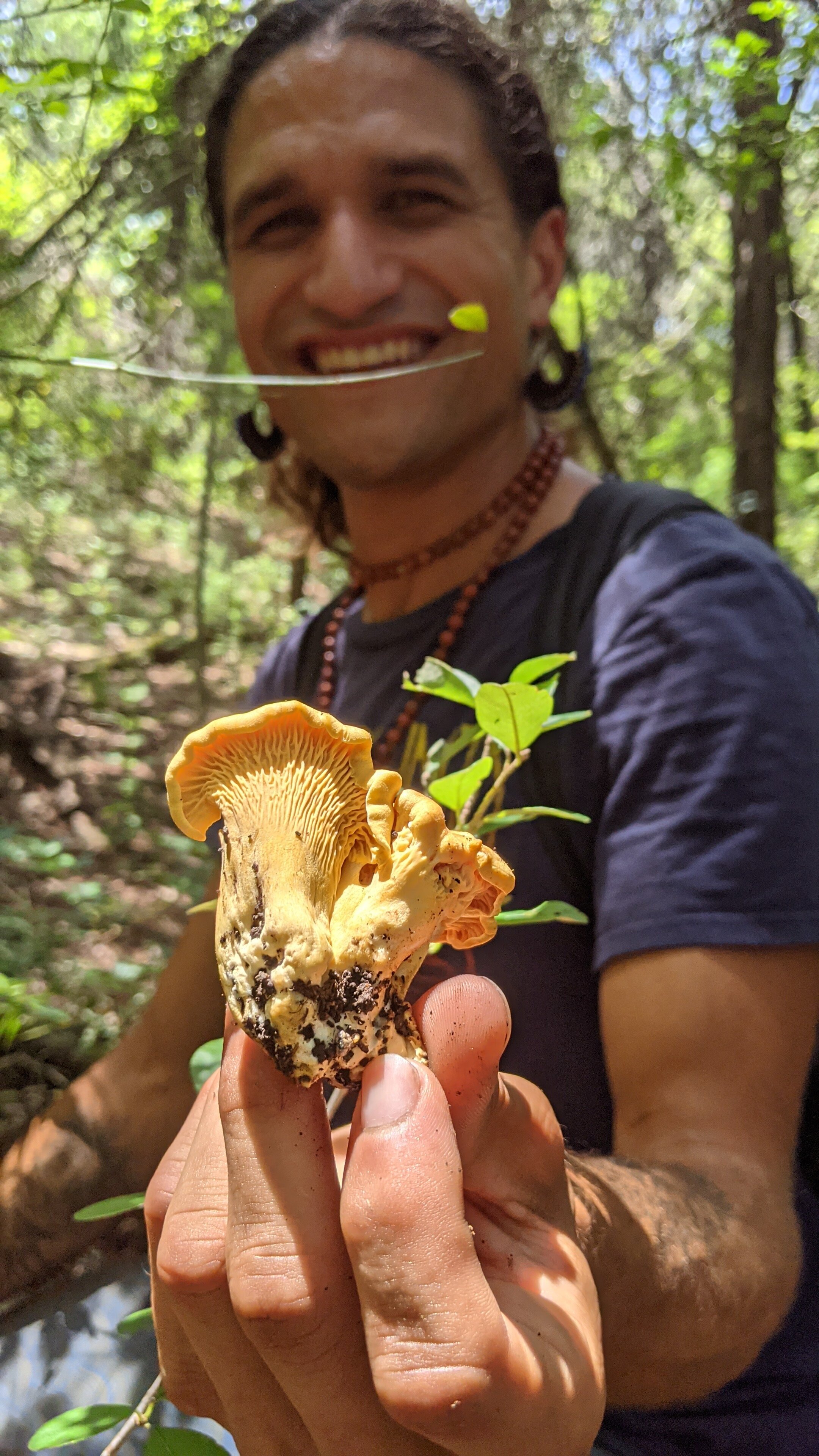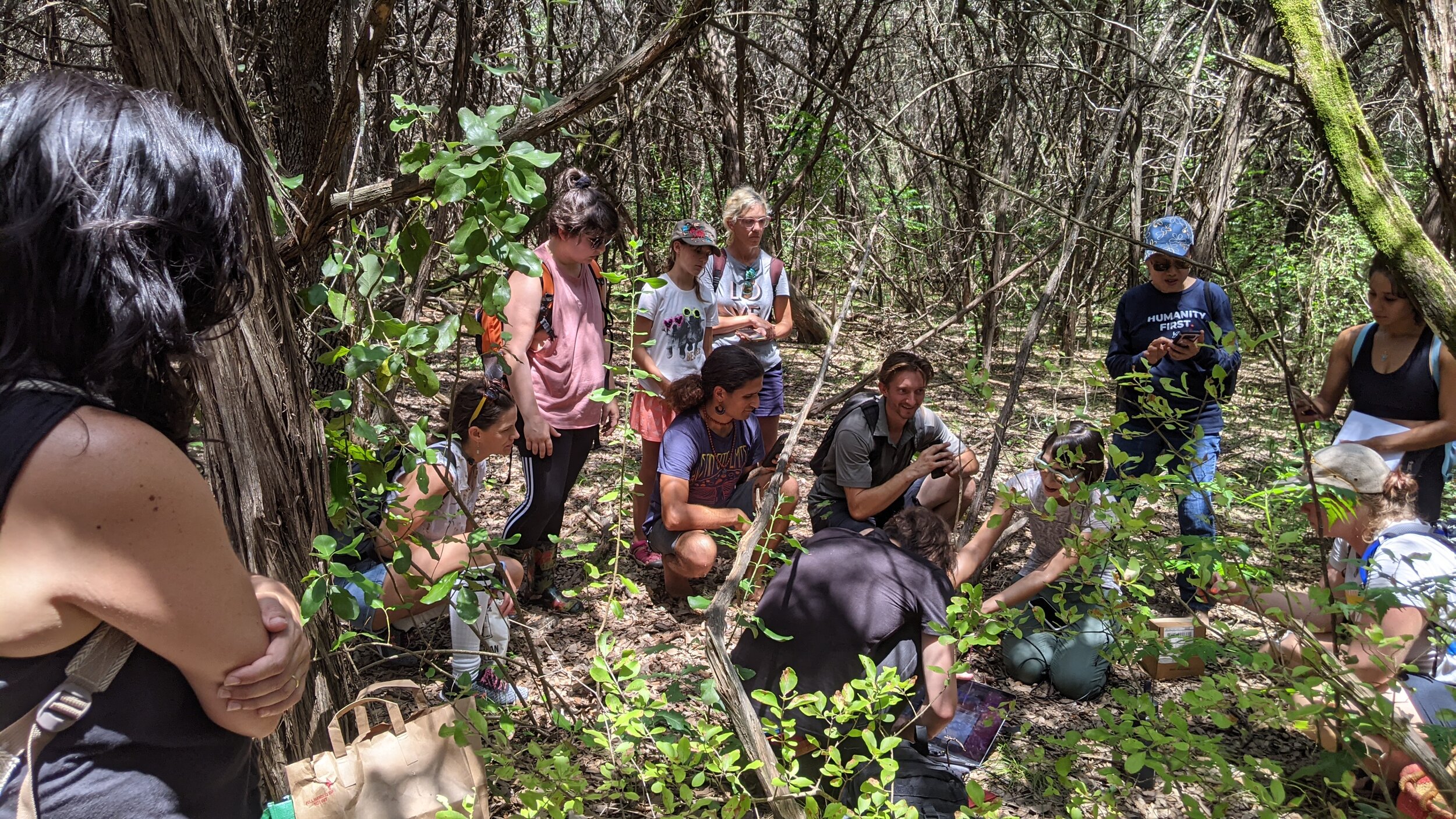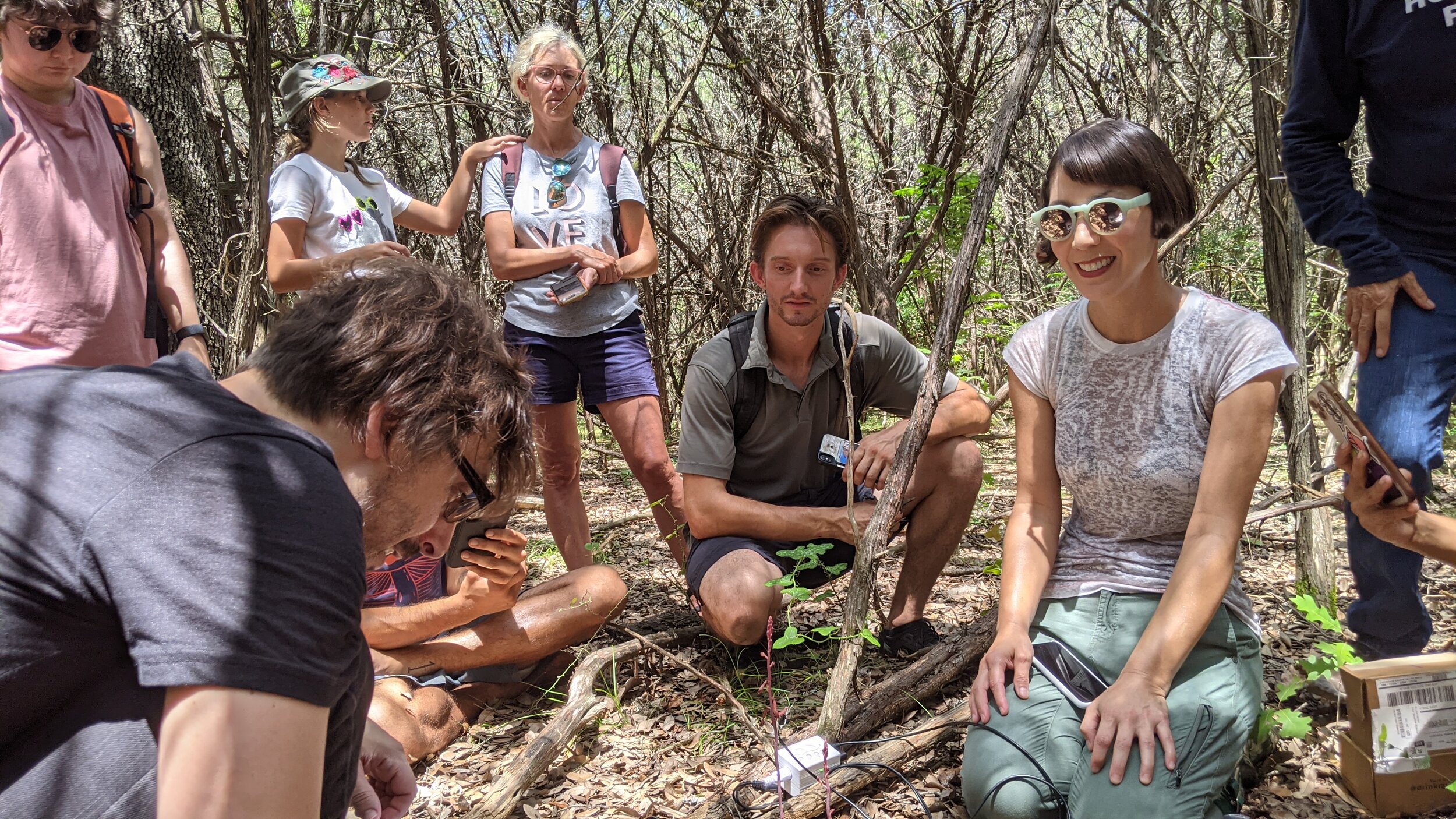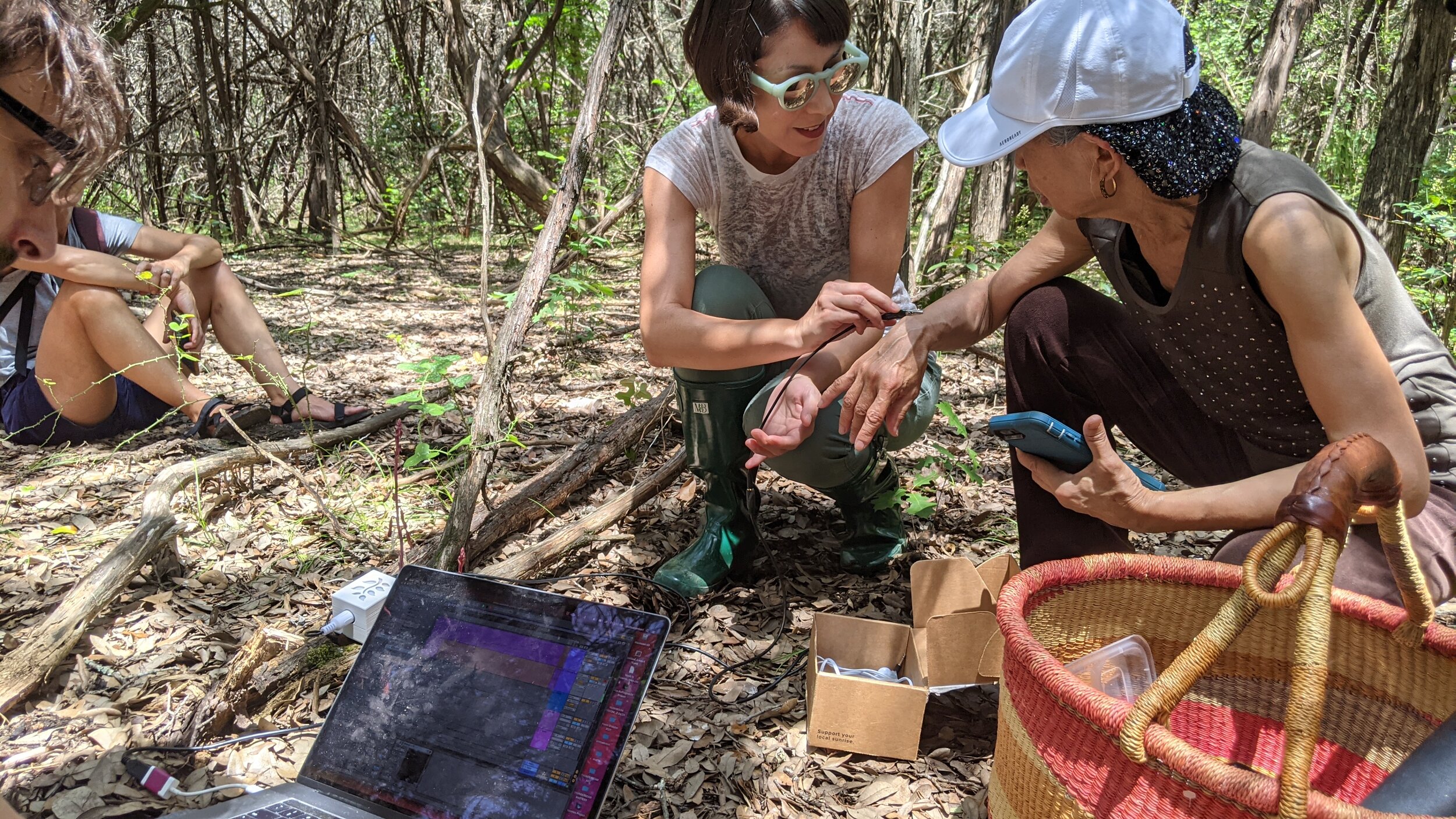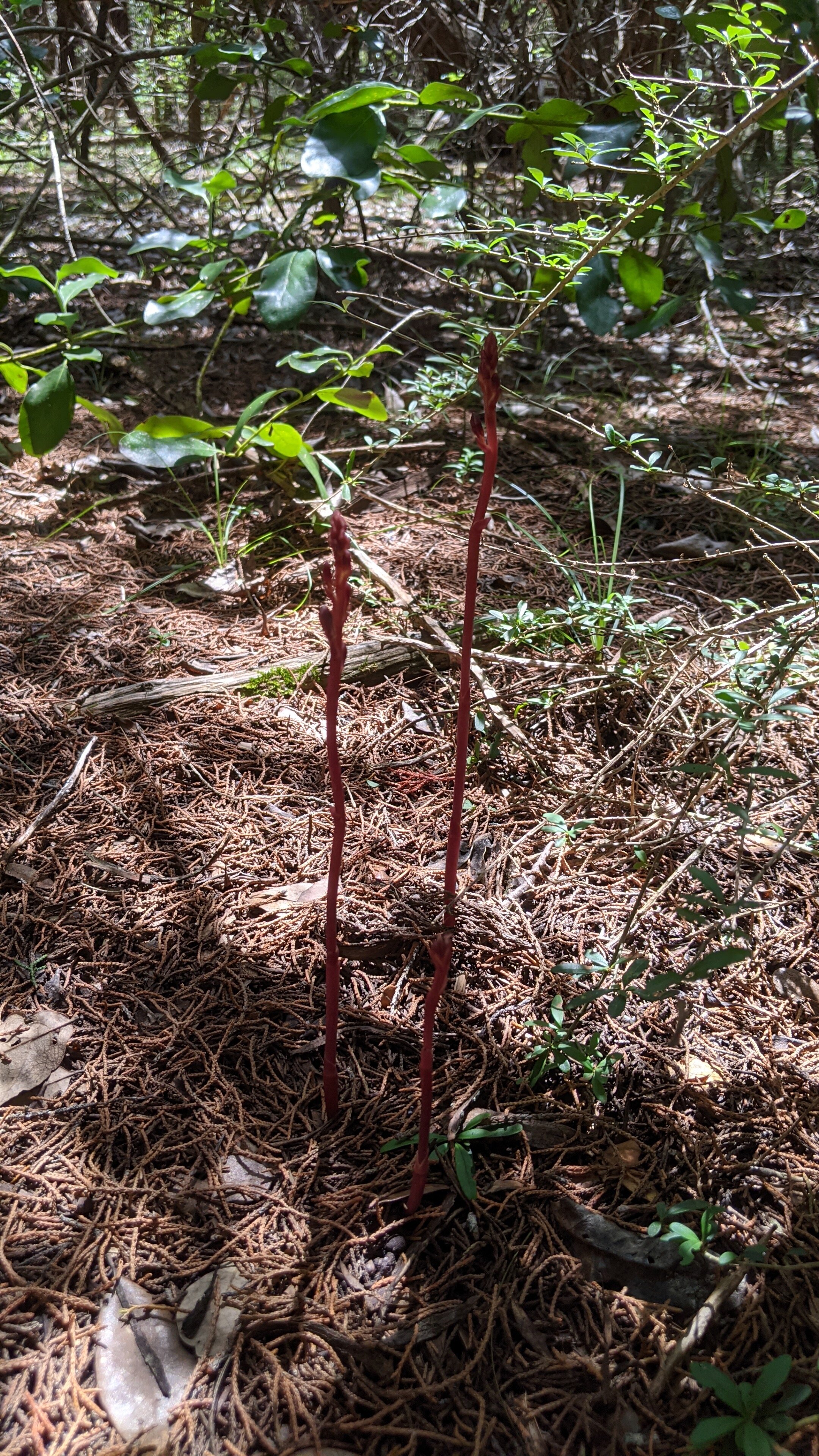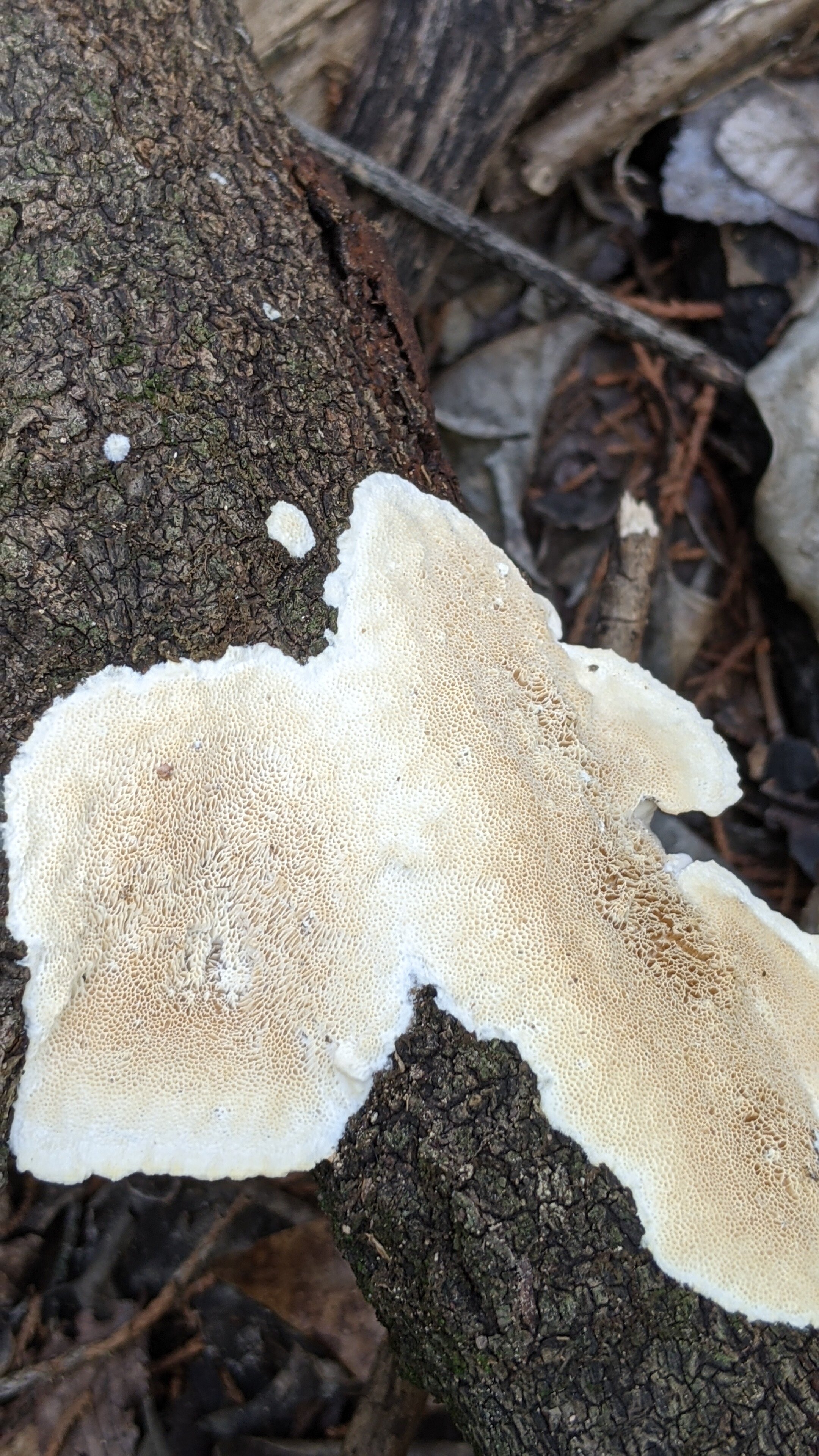It's Chicken of the Woods Season
Forage.atx made this sizzle reel compiling clips from the last few COTW seasons in Central Texas.
Forage.atx made this sizzle reel compiling clips from the last few COTW seasons in Central Texas.
We will be doing more small mushroom ID walks this fall, so if you haven't already, sign-up to become a member and get first pick at ticket for our events. Members also get discounted tickets. If you are a student DM us for our membership discount code.
ABOUT COTW
As temperatures start to cool and trees start to drop their leaves, keep a look out for the orange polypores known as Chicken-of the-Woods (COTW) Laetiporus. They grow on older Texas Live Oaks that have been trimmed and have their heartwood exposed. Spores are everywhere and carry a lot of genetic information. Once two matching spores land in the right place, the fungus will slowly colonize and eat the heartwood of Texas Live Oaks or Quercus fusiformis. If you see a hollow Live Oak, it is likely due to a fungus parasitizing it. Unlike other parts of the country where COTW is a decomposer on dead hardwood, in Central Texas the fungus is a parasite because the trees are still living.
Once you see the fruiting mushroom, there is nothing that will save the tree from slowly decomposing and returning its nutrients back to the soil. Many times it’s not the fungi that is at fault. Human disruption, cutting down trees, and trimming trees for roads and buildings, opens the tree up to the spores that are floating everywhere and waiting for the right opportunity to find a home to feed.
On the plus side, what they spit out is a delicious edible mushroom that contains proteins, fat, fiber and tastes just like chicken! They are also medicinal and rich in antioxidant compounds like chlorogenic acid, caffeic acid, kaempferol, and quercetin. It's also packed with lanostanoids – potent anti-carcinogenic compounds.
Mycology Happy Hour at Live Oak Brewing
A few images from the Mycology Happy Hour at @liveoakbrewing. We are happy to report that there were no chicken-of-the-woods #Laetiporussulphureus found on any of the beautiful, heritage Live Oaks at the brewery. Thanks tree guy! @theymightbemonkeys and thanks @fredlabia for the tour and for going deep on sugar fungus knowledge!
Everyone had a chance to try a nugget of coconut chicken of the woods made by @forage.atx. Consensus... Tastes like chicken. 🐔
Of course, we did spot other fungal activity while running around the disc golf course... because we are fungi freaks of nature. A #sawgill #Lentinuscrinitus and maybe some old #Oakbracket. Whatever it was it smelled like petrol.
@swamppenwolf new to the leadership circle is fitting right into Austin in a hollowed out Eastern cedar... his subtle way of saying he misses Houston. His cute pup is even into fungus and was gnawing on some #hexagoniahydnoides.
Thanks @curlymyco for bringing all the recycled mushroom blocks for everyone to take home.
We are planning to do our October outdoor HH at @jesterkingbrewery because we want to try this new @txsakeco colab mushroom beer #LIGRA and also myceliate with @farmerpeppy and his goats.
🍄💗🍄💗🍄💗
September Forage Forecast
As temps start to cool and trees start to loose their leaves, we start to look for the orange polypores known as Chicken-of the-Woods (COTW) Laetiporus sulphureus. Keep a look out on older Texas Live Oaks that have been trimmed and have their heartwood exposed. Spores are everywhere and carry a lot of genetic information that helps them find the right place to feast. COTW slowly eats the heartwood of Texas Live Oaks that are still alive. If you have ever seen a hollow tree, it is likely due to a fungus parasitizing a tree. Many times it’s not the fungi that is at fault. Human disruption, cutting down tree, and trimming of trees for roads and buildings, opens the tree up to the spores that are floating everywhere and waiting for the right opportunity to have dinner.
ABOVE: COTW that was "car-vested" by @forage.atx. It was spotted as she was driving 80MPH on the interstate just South of San Antonio.
As temperatures start to cool, keep a look out for the orange polypores known as Chicken-of the-Woods (COTW) Laetiporus species. This brown-rot, polypore mushroom fruits on older Texas Live Oaks that have been trimmed and have their heartwood exposed. Spores are everywhere and carry a lot of genetic information. Once a two matching spores land in the right place, the fungus will slowly colonizes and eat the heartwood of Texas Live Oaks or Quercus fusiformis. If you see a hollow Live Oak, it is likely due to a fungus parasitizing it. Once you see the fruiting mushroom, there is nothing that will save the tree from slowly decomposing and returning its nutrients back to the soil. Many times it’s not the fungi that is at fault. Human disruption, cutting down tree, and trimming trees for roads and buildings, opens the tree up to the spores that are floating everywhere and waiting for the right opportunity to have dinner. On the plus side, what they spit out is a delicious choice edible mushroom that contains, proteins, fat, fiber and tastes just like chicken!
Look for Ganoderma, the "Mushroom of Immortality" on dying or dead Pecan trees or stumps. If the top of the shelf looks red and varnished and the underside is still white, it is still good to harvest for medicinal purposes. The species shown above is more likely to be found in East Texas and in Bastrop area.
Auricularia or wood ear an edible jelly fungus pops up on downed hardwood limbs a few days after a good rain. Wood ear mushrooms are a popular ingredient in many Chinese dishes such as hot and sour soup, and are also used in Chinese medicine. It is also used in Ghana as a blood tonic. Modern research into possible medical applications has variously concluded that wood ear has anti-tumor, hypoglycemic, anticoagulant and cholesterol-lowering properties.
Favolus, or honeycomb fungus, is a genus of fungi in the family Polyporaceae. The fruit bodies of Favolus species are fleshy with radially arranged pores on the underside of the cap that are angular and deeply pitted, somewhat resembling a honeycomb. I tried a new recipe recently that has the taste and texture of chicharrones or pig's ears. I also discovered a new paper about its edibility. You can read more about it on our blog.
As always, if you are trying a new mushroom, confirm the ID with an expert, then try a small amount to make sure you don't have an allergic reaction. Texas Mushroom Identification Facebook group is great for quick responses and ID help. Also, don't forget to add your finds on the Mushrooms of Texas project on iNaturalist.
Follow my foraging adventures @forage.atx.
PHOTOS: Marysol Mushrooms Leo Birthday Bash
Marysol filled out mushroom lovin' hearts this weekend at the Leo Birthday Bash! Here are a few photos from the fungi-filled day in Bastrop. We were also joined by Erin from Shroomtownof Houston and Andrew @southtexasseasonals of San Antonio area! Members from the DFW area also joined! Texas hyphaes myceliating!
The day included a foray on the 5-acres behind the farm in the beautiful loblolly pines. Before we entered the forest we spotted several fruiting bodies popping up. #HONGOSTO!!
The walk was followed by a delicious lunch catered by Storehouse Market and Eatery in Bastrop. 😘
The main event was the tour of Marysol's new mushroom farm in a converted shed! You were so impressed by her and Jeff's hard work. Wow! You can pickup Marysols mushrooms at the @farmeredeneast and Boggy Creek farm stands in Austin and Bastrop.
Happy Birthday Marysol!
PHOTOS: Orchid & Mushroom Walk on July 31st
Sam the Fungi and I (Angel) had so much fun meeting everyone yesterday and looking for mushrooms and tuning into the beautiful orchid Hexalectris nitida or Glass Mountain Crested Coralroot
Sam the Fungi and I (Angel) had so much fun meeting everyone yesterday and looking for mushrooms and tuning into the beautiful orchid Hexalectris nitida or Glass Mountain Crested Coralroot. It was so exciting to see more popping up and I encourage everyone to do more hikes and try to observe the orchid while it is blooming. Here is one capture of the orchid blooming in Austin of 2019 and it is stunning.
We hope you enjoyed hearing the biodata recording process and sounds of the orchid with Josh and Yvonne. You can see/hear the The Octopus Projects Mushroom Biodata recordings from the CTMS fundraiser in May here.
More About The Orchid
(From North American Orchid Conservation Center)
Hexalectris nitida, the Glass Mountain Coral Root, is widely scattered across Texas and crosses the north-south border into New Mexico. This leafless orchid has a relatively short inflorescence, usually 20 cm or less, that bears a dense cluster of waxy, rose-brown flowers. The flowers resemble those of H. revoluta, including the rolled-back tips of the sepals and petals but are smaller.
Who First Observed This Orchid
H. nitida was observed by Barton Warnock in 1940 while he was doing field work for his PhD dissertation at UT Austin on the vegetation of the Glass Mountains. This is why it has the common name of Glass Mountain Crested Coralroot. The Glass Mountains in West Texas extend from Cathedral Mountain in northern Brewster County to Monument Draw in southern Pecos County, roughly between Fort Stockton and Alpine.
Why This Orchid is Rare
1. Parasitic: The orchid is mycoheterotrophic. Mycoheterotrophy is the process in which the plant gets it's food from parasitism upon fungi rather than from photosynthesis. A myco-heterotroph is the parasitic plant partner in this relationship.
2. Weather Dependent: It only grows in summer seasons when we get a lot of rain and humidity to create a microclimate that is suitable. (like 2019 and 2021).
3. Geographically Rare: Hexalectris nitida is rare throughout its range and is considered vulnerable. Although it may be locally abundant in Texas and has been reported in Mexico, this orchid has not been observed in New Mexico since its discovery and may be extirpated in that state.
4. Flowers Rarely Display: This orchid is self-pollinating or cleistogamy and rarely displays flowers that are fully open. The short labellum, less than 1 cm long, also distinguishes this species from others in the genus. Hexalectris nitida grows on rocky canyon sides and bottoms in moderate to heavy shade from oaks and junipers.
More About The Hexalectris Genus of Orchids
Texas boasts more species of the genus Hexalectris than any other state. Here 5 of the world’s 8 species can be found (these numbers change to 6 and 9, depending on if you believe that Hexalectris spicata var. arizonica deserves species status). Hexalectris is a genus of myco-heterotrophic orchids that are generally found in areas with abundant shade and thick, rich leaf litter. In Texas there are three Hexalectris hotspots. One is the mountains of far West Texas, another the shaded canyons and oak/juniper woodlands of the Edward’s Plateau, and the last is the White Rock Escarpment of north-central Texas.
Reference Links
https://goorchids.northamericanorchidcenter.org/species/hexalectris/nitida/
https://mattbuckinghamphotography.com/category/hexalectris-nitida/
August Forage Forecast
Look for Ganoderma, the "Mushroom of Immortality" on dying or dead Pecan trees or stumps. If the top of the shelf looks red and varnished and the underside is still white, it is still good to harvest for medicinal purposes. The species shown above is more likely to be found in East Texas and in Bastrop area.
Look for Ganoderma, the "Mushroom of Immortality" on dying or dead Pecan trees or stumps. If the top of the shelf looks red and varnished and the underside is still white, it is still good to harvest for medicinal purposes. The species shown above is more likely to be found in East Texas and in Bastrop area.
Auricularia or wood ear an edible jelly fungus pops up on downed hardwood limbs a few days after a good rain. Wood ear mushrooms are a popular ingredient in many Chinese dishes such as hot and sour soup, and are also used in Chinese medicine. It is also used in Ghana as a blood tonic. Modern research into possible medical applications has variously concluded that wood ear has anti-tumor, hypoglycemic, anticoagulant and cholesterol-lowering properties.
Favolus, or honeycomb fungus, is a genus of fungi in the family Polyporaceae. The fruit bodies of Favolus species are fleshy with radially arranged pores on the underside of the cap that are angular and deeply pitted, somewhat resembling a honeycomb. I tried a new recipe recently that has the taste and texture of chicharrones or pig's ears. I also discovered a new paper about its edibility. You can read more about it on our blog.
As always, if you are trying a new mushroom, confirm the ID with an expert, then try a small amount to make sure you don't have an allergic reaction. Texas Mushroom Identification Facebook group is great for quick responses and ID help. Also, don't forget to add your finds on the Mushrooms of Texas project on iNaturalist.
Follow my foraging adventures @forage.atx.
PHOTOS: Orchid & Mushroom Walk
Sam the Fungi and I (Angel) had so much fun meeting everyone yesterday and looking for mushrooms and tuning into the beautiful orchid Hexalectris nitida or Glass Mountain Crested Coralroot
Sam the Fungi and I (Angel) had so much fun meeting everyone yesterday and looking for mushrooms and tuning into the beautiful orchid Hexalectris nitida or Glass Mountain Crested Coralroot. It was so exciting to see more popping up and I encourage everyone to do more hikes and try to observe the orchid while it is blooming. Here is one capture of the orchid blooming in Austin of 2019 and it is stunning.
We hope you enjoyed hearing the biodata recording process and sounds of the orchid with Josh and Yvonne. You can see/hear the The Octopus Projects Mushroom Biodata recordings from the CTMS fundraiser in May here.
More About The Orchid
(From North American Orchid Conservation Center)
Hexalectris nitida, the Glass Mountain Coral Root, is widely scattered across Texas and crosses the north-south border into New Mexico. This leafless orchid has a relatively short inflorescence, usually 20 cm or less, that bears a dense cluster of waxy, rose-brown flowers. The flowers resemble those of H. revoluta, including the rolled-back tips of the sepals and petals but are smaller.
Who First Observed This Orchid
H. nitida was observed by Barton Warnock in 1940 while he was doing field work for his PhD dissertation at UT Austin on the vegetation of the Glass Mountains. This is why it has the common name of Glass Mountain Crested Coralroot. The Glass Mountains in West Texas extend from Cathedral Mountain in northern Brewster County to Monument Draw in southern Pecos County, roughly between Fort Stockton and Alpine.
Why This Orchid is Rare
1. Parasitic: The orchid is mycoheterotrophic. Mycoheterotrophy is the process in which the plant gets it's food from parasitism upon fungi rather than from photosynthesis. A myco-heterotroph is the parasitic plant partner in this relationship.
2. Weather Dependent: It only grows in summer seasons when we get a lot of rain and humidity to create a microclimate that is suitable. (like 2019 and 2021).
3. Geographically Rare: Hexalectris nitida is rare throughout its range and is considered vulnerable. Although it may be locally abundant in Texas and has been reported in Mexico, this orchid has not been observed in New Mexico since its discovery and may be extirpated in that state.
4. Flowers Rarely Display: This orchid is self-pollinating or cleistogamy and rarely displays flowers that are fully open. The short labellum, less than 1 cm long, also distinguishes this species from others in the genus. Hexalectris nitida grows on rocky canyon sides and bottoms in moderate to heavy shade from oaks and junipers.
More About The Hexalectris Genus of Orchids
Texas boasts more species of the genus Hexalectris than any other state. Here 5 of the world’s 8 species can be found (these numbers change to 6 and 9, depending on if you believe that Hexalectris spicata var. arizonica deserves species status). Hexalectris is a genus of myco-heterotrophic orchids that are generally found in areas with abundant shade and thick, rich leaf litter. In Texas there are three Hexalectris hotspots. One is the mountains of far West Texas, another the shaded canyons and oak/juniper woodlands of the Edward’s Plateau, and the last is the White Rock Escarpment of north-central Texas.
Reference Links
https://goorchids.northamericanorchidcenter.org/species/hexalectris/nitida/
https://mattbuckinghamphotography.com/category/hexalectris-nitida/
PHOTOS: Foray at Bull Creek
So many smiles at the foray at Bull Creek that I shared with Sam theFungi and Central Texas Mycology members. The Cantharellus, Favolus and Hortiboletus continue to make an appearance because of the rainy, tropical, sauna-like weather. We also observed some other interesting fruiting bodies that I had not seen before in Central Texas. View slideshow of mushrooms that we added to iNaturalist.
So many smiles at the foray at Bull Creek that I shared with Sam theFungi and Central Texas Mycology members. The cantharellus, favolus and hortiboletus continue to make an appearance because of the rainy, tropical, sauna-like weather. We also observed some other interesting fruiting bodies that I had not seen before in Central Texas. View slideshow of mushrooms that we added to iNaturalist.
Keep dancing for rain because there will be more forays... Also check out the next foray event for early August in Bastrop at Marysol Mushrooms new mushroom farm. We will be touring her farm and feasting on Lion's Mane because it's Leo season and it will be Marysol and Angel's birthday! A full day of fungal treasures!
July Forage Forecast
Look for Ganoderma, the "Mushroom of Immortality" on dying or dead Pecan trees or stumps. If the top of the shelf looks red and varnished and the underside is still white, it is still good to harvest for medicinal purposes. The species shown above is more likely to be found in East Texas and in Bastrop area.
Look for Ganoderma, the "Mushroom of Immortality" on dying or dead Pecan trees or stumps. If the top of the shelf looks red and varnished and the underside is still white, it is still good to harvest for medicinal purposes. The species shown above is more likely to be found in East Texas and in Bastrop area.
Auricularia or wood ear an edible jelly fungus pops up on downed hardwood limbs a few days after a good rain. Wood ear mushrooms are a popular ingredient in many Chinese dishes such as hot and sour soup, and are also used in Chinese medicine. It is also used in Ghana as a blood tonic. Modern research into possible medical applications has variously concluded that wood ear has anti-tumor, hypoglycemic, anticoagulant and cholesterol-lowering properties.
Favolus, or honeycomb fungus, is a genus of fungi in the family Polyporaceae. The fruit bodies of Favolus species are fleshy with radially arranged pores on the underside of the cap that are angular and deeply pitted, somewhat resembling a honeycomb. I tried a new recipe recently that has the taste and texture of chicharrones or pig's ears. I also discovered a new paper about its edibility. You can read more about it on our blog.
Old-Man-of-the-Woods, Strobilomyces strobilaceusttet is one of North America's most unusual edible wild mushroom. It is a dark, scurfy fungus that is gray-white with tufts of black hair on the cap and a fine layer of dark fur on the mushroom's stem. The species is in the Boletaceae family which means it has pores. They are small; angular; grayish, bruising reddish then black. The stalk is slightly narrower toward the cap usually with one or two ring zones. The partial veil is grayish and sometimes it leaves woolly ring zones on the stalk. It grows on the ground in mixed hardwood forests and on occasion under a conifer. It especially likes oaks.
Not a choice edible but the young fungi have a mellow, earthy flavour. Must be cooked.
As always, if you are trying a new mushroom, confirm the ID with an expert, then try a small amount to make sure you don't have an allergic reaction. Texas Mushroom Identification Facebook group is great for quick responses and ID help. Also, don't forget to add your finds on the Mushrooms of Texas project on iNaturalist.
Follow my foraging adventures @forage.atx.
PHOTOS: Myco-blitz at Balcones Canyonland Preserve
Thanks to Jeremy Hull @bluetip84 and everyone from Balcones Canyonland Preserve @bcp_traviscounty for having us out for our first Myco-blitz! We are so grateful for all of the volunteers that joined us and observed the cycle of mushroom life with us! Even though things are starting to get toasty we observed a lot of diversity of mushrooms and logged the photos on iNaturlist.org.
Here is a slideshow of a few of the observations. You can find more on iNaturalist.
1. Group photo of volunteers
2. #Dacrymycetaceae Jelly fungus
3. Huge cross section of #Xylaria #deadmansfingers. We spotted quite a few different species of this fungus in various stages of growth.
4. #Omphalotussubilludens #jackolanternmushroom This mushroom glows in the dark and you can check out @chungwei3wei beautiful photography of this bioluminescence mushroom.
5. We found several dried #Cantharellus Chanterelles next to different types of oaks including Live Oaks and maybe Post Oaks. Some were even growing under a tarp that was being used in a restoration project to remove an invasive ground cover.
6. #Sarcoscyphaaustriaca #scarletelfcup
7. #Pleurotusostreatus #oystermushroom
We can't wait to come back after the next good rain and continue to explore the biodiversity!
